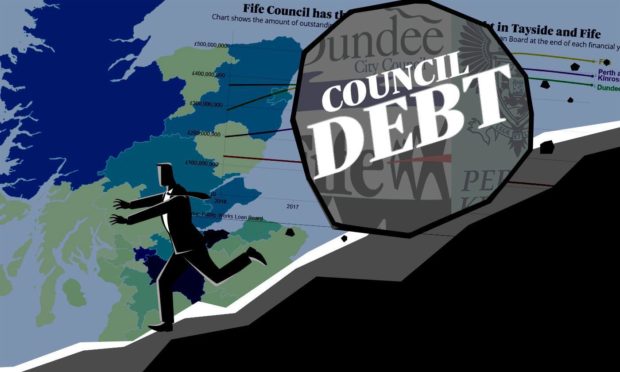The debt mountain owed to the UK Treasury by Scottish councils has topped £11 billion for the first time after huge rises in borrowing in the last year.
Perth and Kinross Council recorded one of the larger increases in Scotland in 2021/22, going up by £77.5m to £568m last year.
Fife Council’s debt soared by £38m to £578m, meanwhile, and Dundee City Council’s increased by just more than £20m to almost £481m.
The value of Angus Council’s outstanding loans was up by £1.5m to £112m.
The increases helped add a total of £722 million to the overall bill owed by Scotland’s 32 local authorities
It marks a return to rising debt levels after the trend was temporarily reversed during the first year of the pandemic, as spending on major building projects ground to a halt.
‘Future proof’
As well as restarting work on high-profile schemes last year, some local authorities said the higher borrowing was a result of efforts to “future proof” them from potential interest rate rises, by switching from short to longer-term loans at a fixed rate.
Councils routinely borrow money to invest in in capital construction schemes such as new schools, leisure and cultural facilities, flood defences, offices and roads.
A key source of the funding is the Public Works Loan Board (PWLB), which is operated by the UK Debt Management Office on behalf of the Treasury.
Newly-published PWLB data shows Moray, Argyll and Bute, Western Isles and Glasgow City were among the dozen councils which bucked the trend by cutting the total amount they owed last year, while there was no change at Orkney Islands and Shetland Islands.
Concerns have been raised in recent years about the rising level of debt at councils, including the risks involved in investing in commercial property, as well as the need to make payments on the loans from day-to-day budgets for services.
Before the pandemic, the amount owed by Scotland’s local authorities had risen in each of the preceding four years from £8.8bn at the end of 2015/16 to £10.6bn in 2019/20.
This included a sharp increase of almost £1bn between 2018/19 and 2019/20, linked to a 1% hike in interest rates from the Treasury.
The upward trajectory was halted in 2020/21 as the pandemic led to work grinding to a halt on key construction projects.
The 32 authorities were able to reduce the combined amount they owed from about £10.63bn to £10.35bn.
However, new figures show the total increased in 2021/22 to £11.07bn.
Aberdeenshire Council’s debt levels increased by almost £120m, a figure topped only by Edinburgh City Council.
Mary Beattie, head of finance at Aberdeenshire Council, said: “In 2021/22 Aberdeenshire Council progressed some large infrastructure projects including the new energy for waste plant, our housing improvement programme and our new homes project which account for some of the increase in borrowing.
“We have also worked to ‘future proof’ some of our borrowing from any potential interest rate rises.
“This means we have essentially ‘consolidated’ existing short-term variable borrowing to a fixed rate from the Public Works Loan Board”
